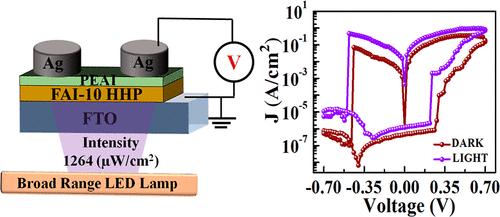当前位置:
X-MOL 学术
›
ACS Appl. Electron. Mater.
›
论文详情
Our official English website, www.x-mol.net, welcomes your feedback! (Note: you will need to create a separate account there.)
Electro-Optically Tunable Passivated Double-Cation Perovskite-Based ReRAM for Low-Power Memory Applications
ACS Applied Electronic Materials ( IF 4.7 ) Pub Date : 2024-03-18 , DOI: 10.1021/acsaelm.4c00257 Manvendra Chauhan 1 , Ranbir Singh 2 , Satinder K. Sharma 1
ACS Applied Electronic Materials ( IF 4.7 ) Pub Date : 2024-03-18 , DOI: 10.1021/acsaelm.4c00257 Manvendra Chauhan 1 , Ranbir Singh 2 , Satinder K. Sharma 1
Affiliation

|
3-D Hybrid halide perovskites (HHPs) have garnered significant interest as a promising contender for next-generation resistive random access memory (ReRAM) technology. However, challenges such as variations in cycle-to-cycle switching iterations, operating voltages, and restrained reproducibility arise due to the disproportionate presence of grain size (GS) and grain boundaries (GBs), which are impediments to the widespread adoption of perovskite-based memory devices in commercial applications. Since GBs present in the thin film act as pathways for ion/cation migrations that eventually lead to the formation of conducting filament (CF), by regulating GBs, the resistive switching (RS) performance of the memory devices can also be improved. Herein, we initially optimized GS and thus GBs in the 3-D HHP thin film by the incorporation of FA+ in the MAPbI3 3-D HHP to prepare double-cation 3-D MAFAPbI3 HHP and determined that the doping of 10% FAI improved the MAFAPbI3 film quality with an average grain size of ∼209.68 and 6.65 nm surface roughness, resulting in higher GBs that led to the stable RS of the fabricated Ag/MAFAPbI3/FTO up to 491 cycles under dark conditions and 245 cycles under white light illumination with significantly low statistical variations (σ/μ %) in the consecutive switching cycles. This performance was achieved while maintaining low-resistance states (LRS) and high-resistance-states (HRS) ratios, i.e., LRS/HRS of ∼15.2 (dark) and ∼54.3 (white light) conditions at power consumption of ∼0.101 mW. Further, to improve LRS/HRS, the PEAI passivation layer was deposited over the optimized MAFAPbI3 switching layer (SL) through spin-coating, and the fabricated Ag/PEAI/MAFAPbI3/FTO ReRAM configuration exhibited LRS/HRS ∼105 at considerably low power, i.e., 0.12 and 0.23 mW while operating under dark and white light illumination, respectively. Furthermore, the RS mechanisms of Ag/MAFAPbI3/FTO and Ag/PEAI/MAFAPbI3/FTO were discussed and supported by the electrochemical metallization (ECM) model.
中文翻译:

适用于低功耗存储器应用的电光可调钝化双阳离子钙钛矿 ReRAM
3-D 混合卤化物钙钛矿 (HHP) 作为下一代电阻式随机存取存储器 (ReRAM) 技术的有力竞争者,引起了人们的极大兴趣。然而,由于晶粒尺寸(GS)和晶界(GB)不成比例的存在,出现了诸如周期间切换迭代变化、工作电压和受限再现性等挑战,这阻碍了钙钛矿的广泛采用。基于商业应用的存储设备。由于薄膜中存在的GB充当离子/阳离子迁移的通道,最终导致导电丝(CF)的形成,因此通过调节GB,还可以提高存储器件的电阻开关(RS)性能。在此,我们首先通过在 MAPbI 3 3-D HHP中掺入 FA +来优化 3-D HHP 薄膜中的 GS 和 GB ,以制备双阳离子 3-D MAFAPbI 3 HHP,并确定 10% 的掺杂FAI 提高了 MAFAPbI 3薄膜质量,平均晶粒尺寸为 ∼209.68,表面粗糙度为 6.65 nm,从而产生更高的 GB,从而使制造的 Ag/MAFAPbI 3 /FTO 的稳定 RS 在黑暗条件下高达 491 次循环和 245 次循环在白光照明下,连续开关周期中的统计变化 (σ/μ %) 非常低。该性能是在保持低阻态 (LRS) 和高阻态 (HRS) 比率的同时实现的,即在 ∼0.101 mW 的功耗下,LRS/HRS 为 ∼15.2(暗)和 ∼54.3(白光)条件。 。此外,为了提高LRS/HRS,通过旋涂在优化的MAFAPbI 3开关层(SL)上沉积PEAI钝化层,并且制造的Ag/PEAI/MAFAPbI 3 /FTO ReRAM配置在10 5℃下表现出LRS/HRS~10 5相当低的功耗,即在暗光和白光照明下工作时分别为 0.12 和 0.23 mW。此外,还讨论了Ag/MAFAPbI 3 /FTO和Ag/PEAI/MAFAPbI 3 /FTO的RS机制,并得到电化学金属化(ECM)模型的支持。
更新日期:2024-03-18
中文翻译:

适用于低功耗存储器应用的电光可调钝化双阳离子钙钛矿 ReRAM
3-D 混合卤化物钙钛矿 (HHP) 作为下一代电阻式随机存取存储器 (ReRAM) 技术的有力竞争者,引起了人们的极大兴趣。然而,由于晶粒尺寸(GS)和晶界(GB)不成比例的存在,出现了诸如周期间切换迭代变化、工作电压和受限再现性等挑战,这阻碍了钙钛矿的广泛采用。基于商业应用的存储设备。由于薄膜中存在的GB充当离子/阳离子迁移的通道,最终导致导电丝(CF)的形成,因此通过调节GB,还可以提高存储器件的电阻开关(RS)性能。在此,我们首先通过在 MAPbI 3 3-D HHP中掺入 FA +来优化 3-D HHP 薄膜中的 GS 和 GB ,以制备双阳离子 3-D MAFAPbI 3 HHP,并确定 10% 的掺杂FAI 提高了 MAFAPbI 3薄膜质量,平均晶粒尺寸为 ∼209.68,表面粗糙度为 6.65 nm,从而产生更高的 GB,从而使制造的 Ag/MAFAPbI 3 /FTO 的稳定 RS 在黑暗条件下高达 491 次循环和 245 次循环在白光照明下,连续开关周期中的统计变化 (σ/μ %) 非常低。该性能是在保持低阻态 (LRS) 和高阻态 (HRS) 比率的同时实现的,即在 ∼0.101 mW 的功耗下,LRS/HRS 为 ∼15.2(暗)和 ∼54.3(白光)条件。 。此外,为了提高LRS/HRS,通过旋涂在优化的MAFAPbI 3开关层(SL)上沉积PEAI钝化层,并且制造的Ag/PEAI/MAFAPbI 3 /FTO ReRAM配置在10 5℃下表现出LRS/HRS~10 5相当低的功耗,即在暗光和白光照明下工作时分别为 0.12 和 0.23 mW。此外,还讨论了Ag/MAFAPbI 3 /FTO和Ag/PEAI/MAFAPbI 3 /FTO的RS机制,并得到电化学金属化(ECM)模型的支持。



























 京公网安备 11010802027423号
京公网安备 11010802027423号